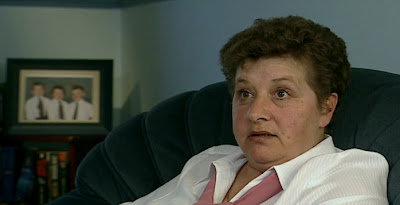



In his films
7 Plus Seven, 21 Up, 28 Up, 35 Up, and 42 Up (1998) Michael
Apted introduces his characters with narrated capsule biographies using memorable scenes from the past films. Within these brief bios,
Apted often uses images to telegraph personal traits. For example, one short sequence from
35 Up (repeated in
42 Up) demonstrates Bruce's humility and genuine love of learning: the camera pans across a classroom of kids in Bangladesh, revealing Bruce as just another student in the class (top still).
Apted's recaps of Suzy's privileged life include footage of a dog chasing after and chewing over a rabbit in a handsome garden (second still: from
7 Plus Seven). Using this same dog-and-bunny scene in every subsequent film allows the viewer to feel the irony of the
filmmaker's compulsion to chase after and chew over all the individuals, Suzy among them, who participated in the original
Seven Up documentary. Indeed,
Apted persistently puts Tony and Symon (above, third and fourth stills) on the spot when he keeps carping on their feelings about money, goals, success and failure.



















































